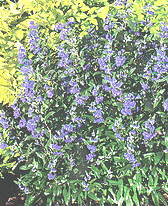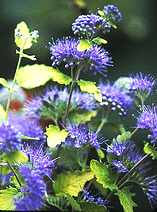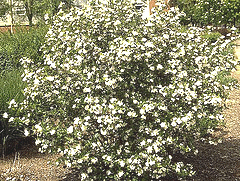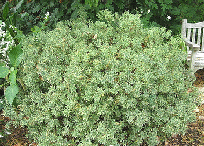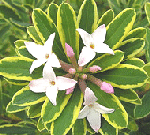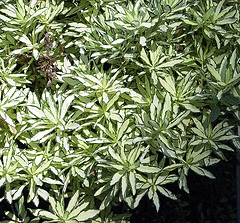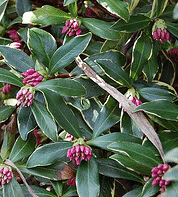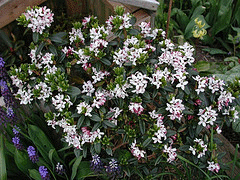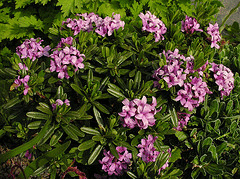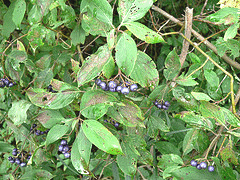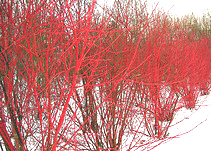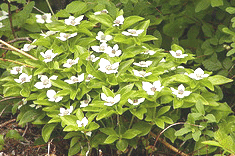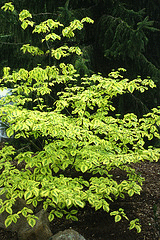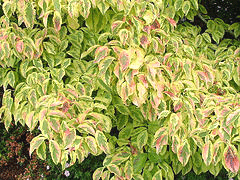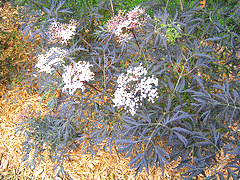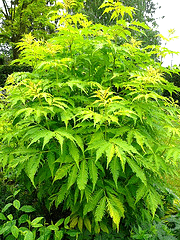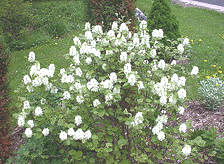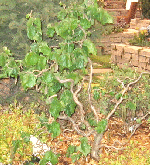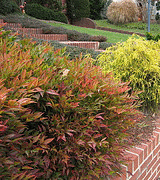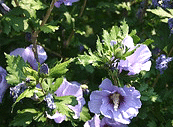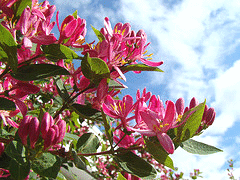Best Performing Shrubs
Caryopteris (Blue Mist Shrub): (Caryopteris) Blue Mist Shrubs produce blue flowerspikes from midsummer to fall. Foliage is aromatic. They are great for low hedges planted two feet apart, or create a stunning effect in groups. They are easy to grow, heat and drought tolerant, and resistant to deer. Do not overwater! They grow quickly and thrive in average soil, but do prefer well drained, loose and loamy. Blue Mist is also loved by butterflies.
‘Blue Beard’ also known as ‘Blue Mist Spirea’ (C. x clandonensis ‘Blue Mist’) Full Sun Hardy in zones 5-9 Flowering shrub. ‘Blue Beard’ has a compact mounding growth habit, reaching about 2 1/2 feet high and 2 feet wide, growing at a moderate rate. Fragrant foliage is silvery blue green, and blooms are misty blue in late summer and early autumn, blooming for a long period. It is widely adaptable to soil types and conditions, except perpetually moist.
‘Longwood Blue’ (C. x clandonensis) Full to part sun Hardy in zones 5-9 Flowering shrub. This classic variety of blue mist shrubs has a beautiful upright growth habit. Highly aromatic spicy scented foliage is silvery and sky blue blooms are produced heavily over a long period. Bloom stems cut for bouquets last a week or longer. Perfect for hedges, borders, foundation plantings and even containers. Plant in sunny dry areas, detests wet conditions.. Prune in very early spring. Grows to at least 2 feet high and wide.
‘Sunshine Blue’ (C.incana) Full sun to light shade Hardy in zones 5-8 Flowering shrub. Foliage is bright yellow, tinged green. Deep blue flower spikes are 6” tall from midsummer until fall. Full growth and superior branching for a strong shrub. Reaches 30” tall and 36” wide. Prefers well drained soil, does not like moist conditions. Prune in very early spring. Will die back north of zone 5, but should regrow readily.
Chokeberry: (Aronia melanocarpa ‘Autumn Magic’) Full sun to part shade Hardy in zones 3-7 Flowering shrub. A large shrub with glossy green foliage that turns fire red in autumn. White scented flower clusters in spring are followed by large edible berries that mature over summer. Upright growth reaches 5 feet and 3-5 feet wide. Chokeberry prefers full sun for best flowering and is very drought tolerant. Adapts easily to a variety of soils as long as it is well drained.
(Aronia malanocarpa elata) ‘Glossy Black Chokeberry Full sun to part shade Hardy in zones 3-7 Flowering shrub. This large landscape shrub has a compact, rounded form. It is very hardy and adaptable to wet or dry conditions. White flowers appear in May and are followed by black fruit. Fall foliage color is brilliant red. Grows to 4-6 feet high and wide.
Daphne: Full sun to part shade Hardy in zones 4-7 Flowering shrub. The striking 'Carol Mackie' is easy to grow in ordinary soil up to zone 4. The dense rounded flowering shrub has unusually variegated leaves, with a golden yellow band around each edge. Abundant star shaped pale pink flowers in May and June are richly fragrant. Reblooming may occur, and tiny red fruits replace the blooms in fall. ‘Carol Mackie’ Daphne requires well drained soil and prefers neutral to slightly acidic soil. Preferring dry soil conditions, Daphne is drought resistant. Grows slowly but reliably, reaching a rounded 3’ high and ups to 4 - 6’ wide. Evergreen in mild regions. Deer resistance is a bonus. Daphne requires little or no pruning and little or no fertilizer. Hardiness is generally listed as up to zone 5, but it has proven to be hardy in zone 4, down to 30 degrees below F. Hard pruning after a killing frost is suggested where snow cover is heavy to prevent branch damage by heavy wet snows. The plant usually rebounds quickly the following spring. Note that Daphne foliage and fruit are poisonous if ingested. Daphne is also known to inexplicably die, for no apparent reason. Do avoid disturbing the roots and do not attempt transplant.
'Briggs Moonlight' foliage is a reverse variegated version of the 'Carol Mackie'. The leaves have creamy yellow centers with green margins. Pink buds open to pale pink to white blooms that attract butterflies. The compact, rounded shrub grows only to a 2 foot mound. Prefers full sun, neutral sandy soil, minimal watering, and will benefit from winter protection even in zone 4. Daphne is generally hardy to zone 4. Soil must be well drained. Should not be pruned unless necessary or transplanted. Like other Daphnes, ‘Briggs Moonlight’ may die for no apparent reason. Many gardeners are so enamored by the gorgeous foliage, that they will plant it over and over nonetheless. All parts of the plant are poisonous.
‘Aureomarginata’ is a bit more adaptable and easier to grow than other daphnes. It is the most aromatic. In early spring, purple buds open to pale pink to white blooms in April and May. Long narrow leaves are dark green with bright gold margins. A rounded form is well branched and upright and grows fairly quickly to 4 or 5 feet tall and spreads to 5 or 6’ wide. Plant in a cool moist location with rich, well drained soil. Often referred to as winter daphne, gardners in mild regions have found success with this daphne when grown in light to part shade. It is not fond of hot, midday sun. ‘Aureomarginata’ prefers light shade and is only hardy to zone 7, as are several other varieties of Daphne.
‘Retusa’ grows densely mounded reaching only 2 to 3 feet high and wide. The blooms are fragrant borne in dense clusters of pink with pink tinged centers. Foliage is leathery and shiny dark green. This is a very easy to grow daphne requiring full sun to part shade and moist well drained soil. Bright red drupes attract birds. Hardy in zones 6 to 9.
‘Lawrence Crocker’ is a dense, compact shrub reaching only about 12” tall and wide. Blooms are sweetly fragranced and vivid pink, blooming from spring through summer. Plant in sun to part shade in enriched moist soil, providing regular watering to ensure good health. Mulch year round to retain moisture and keep roots cool in summer. Thick leaves are textured bright green. This is an excellent daphne for rock gardens or the front of a shrub border or foundation planting. Although hardy to zone 6, ‘Lawrence Crocker’ should be protected from harsh winter exposure.
Dogwood: (Cornus) Full sun to shade Hardy in zones 2-8 Flowering shrub. A staple of the northern landscapes, there is a versatile variety of hardy shrub and tree form available for northern climates. C.alba 'Elegantissima' is probably the most common in the north as a property corner anchor or screen due to it's large size (up to 10 feet). This red twigged dogwood has variegated leaves, providing summer and winter interest and texture. It displays the best fall color in full sun, with shades of gold, apricot and rose, but will do well in part shade. Bright red bark in winter is a bright spot in the landscape. Also tolerates damp soil very well and is hardy to zone 2,
C. amomum ‘Silky Dogwood’ is another large dogwood that is excellent for screening, windbreaks and stabilizing stream banks. For some reason it loves the Great Lake states, but doesn’t do as well outside the area other than some areas of the southeast Dark green leaves with white flowers grows in an upright, rounded habit, reaching 6-10 feet tall. It loves moist, poorly drained and slightly acidic soils. Branches that come in contact with the ground will root and form a thicket.
C. sericia ‘Red Osier’ dogwoods are also hardy to zone 2, reaching 7-10 feet high and wide. You will find many C. sericia with many different names, including the ‘Red Osier’, ‘Red Twig’, ‘American’, ‘Western’ and ‘Red Stem’. They are all nearly the same plant, perhaps with minor differences. Most of the ‘Red Osiers’ are fast growing. ‘Isanti’ has bright red winter stems, the most colorful of the Red Osiers, and is 5-7 feet tall. It is slow growing and dense with red twigs. Fruits heavily to attract birds.
C. canadensis 'Bunchberry, Dwarf Cornel' is a creeping species, actually a subshrub that spreads by rhizomes. ‘Bunchberry’ requires shade to be at its’ best, and prefers moist, well drained, acidic soil. Soil must be cool, 65 degrees or less. It is only 2-8” tall. White flowers in June or July are followed by edible berries.
C. alternifoilia 'Golden Shadows' displays the graceful habit of a Pogoda, with lime green leaves edged in gold. ‘Golden Shadows’ is a large enough shrub to be trimmed into an ornamental tree. Fragrant white flowers in June are followed by dark blue fruit.
Most dogwoods do not like a lot of sun, plant in shade to part shade. Most are also quite tolerant of diverse conditions and are easy to grow with little care required.
C. alba ‘Elegantissima’ Silverleaf Dogwood is very commonly grown in the North and Midwest because it is so hardy and adaptable. Lovely variegated foliage is green with creamy white edges. Red purple branches stand out against the snow in winter. Silverleaf will grow well in sun, part shade or shade and is hardy to zone 2. This is a large shrub, reaching easily 7 feet high and 5 feet wide. Size is easily controlled by regular pruning.
Elderberry: (Sambucus ) European Elderberry are quite large shrubs, larger than our American native Sambucus canadensis, that produce large flat cluster of flowers in spring, and large clusters of black berries in fall. In general, they like moist, well drained soils, but will tolerate both wet and dry, as well as alkaline soils. They will also tolerate windy sites. Elderberry may tend to sucker, and may need occasional pruning to hold a good form. Aphids problems are common, and occasionally may have trouble with borers, cankers and mildew.
Sambucus nigra ‘Eva’ (Black Lace Elderberry) Full sun to part shade Hardy in zones 4-7 Flowering shrub. ‘Black Lace’ has deep dark purple foliage that is lacy and finely cut. The effect is a similarity to Japanese Maple. Leaves hold their color well even in the extreme heat of the southern zones. Pink buds open to lacy white blooms May through June. Mature size is 8-10 feet tall and wide, or larger in ideal conditions. Makes an excellent specimen plant, and contrasts pale or bright foliage beautifully.
Sambucus ‘Sutherland Gold’ Full Sun Hardy in zones 3-8 Flowering shrub. Foliage is bright golden, with deeply cut leaves with a fern-like effect. New growth starts out bright coppery red, then to golden yellow, and finally mellows to a lime green. Masses of creamy white star shaped flowers develop into red fruit clusters that attract birds. This tough plant does well on a southern exposure, standing up well to all day sun and heat. But it does enjoy some sun protection to avoid leaf scorch in more southern zones. Deer Resistant. Mature size is 12 feet high and 8 feet wide. Growth can be restrained with regular pruning.
Forsythia: Full sun Hardy in zones 4-8 Flowering shrub. This shrub is best known for its' showy brilliant yellow flowers in early spring. They need some space, as they can grow quite large, with long arching branches sprawling wildly. They will prune well to keep in check, but remember never to prune until after they have flowered. Prune out the oldest wood down to the ground. Forsythia blooms on old wood, so don’t remove too many branches each pruning to preserve blooms. Will tolerate severe renewal pruning if necessary. Forsythia thrives in ordinary soil in full sun or light shade. Will tolerate alkaline soils, and prefers moist, well drained. The hybrids are generally hardy to zone 3 or 4. 'Spring Glory' (F. x intermedia) explodes in pale yellow blooms in April, reaching 6-8 feet tall and wide, and is hardy to zone 3. Form is upright with slightly arching branches. ‘Spring Glory’ is rust resistant. 'Gold Tide' is a dwarf that only reaches 2-3 feet, spreading to 4 feet - excellent for a slope or trailing over a wall. It is compact with a ground hugging habit and is excellent for mass plantings. Yellow blooms appear in early spring. It is not tolerant of dry soils and needs good snow cover for consistent spring bloom. Hardy to zone 4. ‘Northern Gold’ was developed in Canada and is truly northern hardy. Flower buds are cold hardy and reaches 6-8 feet tall and wide, with an upright habit. Hardy to zone 4, hardy in zone 3 other than perhaps the most severe winters, and will hold up well even in zone 2 with shelter and adequate snow cover.
‘Kumson’ is a unique Korean cultivar that has interesting dark green leaves with silver veins, providing season long interest unusual to forsythia. The leaf patterns are most pronounced on new growth, so frequent pruning will encourage more foliage interest but reduce the flowering. Yellow flowers appear in early spring like all cultivars. Will do fine in sun, but does best in shade to part shade. It grows well in most soils and is drought resistant once established. ‘Kumson’ reaches 8-10’ tall and 7-9’ wide, and is hardy to zone 4. Forsythia ovata varieties are hardy to zone 5. Ovata is known as the Early Forsythia, and grows to 4-6 feet. For best flowering for all forsythia, severely prune old wood immediately after bloom.
Fothergilla: (Fothergilla gardenia) ‘Dwarf’Full to part sun Flowering shrub Hardy in zones 5-8, perhaps 4. This is a small dense shrub with unusual 1-2” bottlebrush flowers that are creamy white and fragrant. The multi-stemmed suckering bush is compact and rounded to upright oval. Foliage is blue green with pale green undersides. Fall color is inconsistent but generally excellent, ranging from yellow-orange to red-purple. Fothergilla prefers an acidic, cool, well drained soil. Mature size is 2-3’ high and wide.
(Fothergilla major) ‘Mount Airy’ is a much larger shrub, reaching 5-6’ high and 4-5’ wide, but is know to grow even larger in good conditions. ‘Mount Airy’ prefers full sun, it will tolerate light shade but will not flower as prolifically or produce good fall color. White bottlebrush blooms in May are somewhat fragrant. Foliage is dark green and underside is a grayed white. Fall color is a superior orange to red. ‘Mount Airy’ is most flattered by a dark evergreen background. Wonderful alternative to smokebush, used as a foundation planting, shrub border or in open “natural” areas.
Harry Lauder’s Walking Stick: (Corylus avellana contorta) Full sun to part shade Hardy in zones 4-8. If you are looking for something REALLY unusual, this is it. Unbelievably contorted branches that go way beyond the term winter interest. Striking accent especially in a contemporary or oriental landscape. Spring produces showy yellow 2-3 inch catkins, and inconspicuous red flowers on female plants. Rarely produces a fruit, but may produce nuts. Cut branches are a great accent to your fresh, or silk arrangements. Does well in sun or shade, southern exposure may be best, in average well drained soil. Will benefit from protection from the hottest afternoon sun. Can reach 8-10 feet tall. Thinning will increase the summer interest by exposing more of the contorted branches. This is the only necessary pruning other than removing suckers if you want to retain the natural beauty of this shrub. Dry the thinned out branches to use in floral arrangements. Although the plant seems to be pretty hardy, do try to buy own root in case of die back. They are generally grafted to Corylus colurna, and tends to grow suckers which must be pruned out. Also known as Corkscrew Hazel and Contorted Filbert.
Heavenly Bamboo (nandina domestica) Full sun to part shade Hardy in zones 6-9 Flowering shrub. Although completely unrelated to bamboo, the fine lacy foliage growing on cane like stalks does resemble bamboo. ‘Nandina’ is not fully hardy in the north and Midwest, as the canes will die back at around -10 degrees, but does grow back vigorously each spring. The interesting and colorful foliage provides wonderful color and texture to the garden, with the color becoming most intense in full sun. More southern climates should plant in late day shade to give it some protection from the most intense heat. Also protect from harsh winds. This shrub is very tough and adaptable but does prefer a rich acid soil and moist conditions. Short periods of drought can be tolerated. Foliage emerges in spring bronzey red followed by 6 - 12 inch panicles of creamy flowers. The foliage matures to blue green and finally fades to green. If left unpruned, berry clusters develop and ripen to bright red. Foliage color changes to pink and red in autumn, ending in a bright red with the red berries. The shrub can become quite large in warmer climates reaching up to 8 feet and 4 - 6 feet wide. Where winter causes die back the shrub remains smaller. Size is easily controlled by pruning. Left unpruned, Heavenly Bamboo will create a lovely screen or hedge, attracting bees with it’s blooms and birds with its’ berries. Prune in spring to control size and increase density. Renew by pruning the oldest branches and weak growth at ground level.
Hibiscus: (syriacus) Full sun to part shade Hardy in zones 5-8 Flowering shrub. Here, referring to the woody shrub, is only hardy to zone 5. Also known as the Rose of Sharon, 'Sanchoyo' with deep rose-pink double flowers, or 'Blue Bird', with huge single blue blooms, are absolutely stunning and bloom all summer. They are both a tall, narrow shrub (7-12 feet high and 3-5 feet wide) that is hard to find for filling corners or landscaping with all summer blooms. There are several cultivars including ‘Diana’ with pure white flowers; ‘Jeanne d’Arc’ with double white flowers; and ‘Lucy’ with double red flowers. None are successful in zone 4 without protection. Hibiscus and ‘Rose of Sharon’ should be heavily mulched in zone 5 to ensure the roots are protected. In regions that drop below -38 degrees, further protection is advised, treating the plant almost like a hybrid tea rose. Mound several inches of soil at the base of the plant, and mulch heavily. Hibiscus prefers moist well drained soils and is tolerant of alkaline soil. Annual pruning in early spring will improve flowering.
Honeysuckle Bush, dwarf: (Diervilla Lonicera) Full sun to full shade Hardy in zones 3-7 Flowering shrub. This is one tough little shrub. Excellent for difficult sites such as slopes, or naturalizing and mass planting, or along a wood’s edge. Foliage is bronze-green. Small yellow flowers are produced in late spring. Bees, butterflies and birds are attracted to the blooms. Tolerates shade. Fall foliage is red. Grows to 4’ high and wide. Diervilla sessillifolia ‘Butterfly’ is similar, with a compact growth habit. Bright green foliage and early summer yellow flowers, prefers full to part sun. Will adapt to dry shade. Reaches about 3-5’ high and wide, and is hardy in zones 4-7. Lonicera ‘Honeyrose’ was introduced by the University of Minnesota, a testament to its’ hardiness, and has rosy red flowers in early to midsummer. Foliage is deep blue-green and is resistant to Honeysuckle witches broom aphid. It makes a wonderful informal hedge or screen. Good for difficult sites and windbreaks. Grows well in full sun to part shade, reaching 10’ high and 8-10’ wide. Hardy in zones 4-7.
